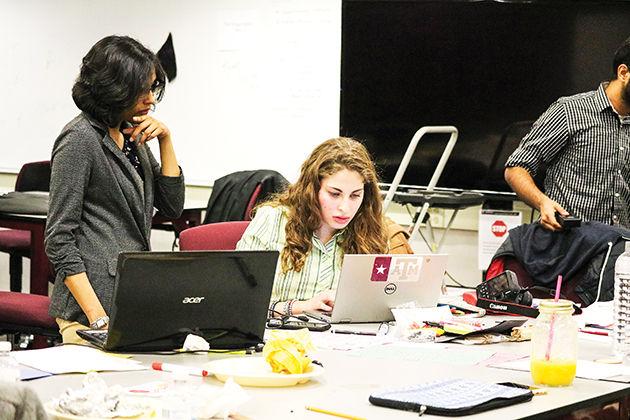The World Economic Forum ranks the United States as No. 48 in quality of math and science education. In just 48 hours, the 60 student participants in Aggies Invent this weekend came up with ideas to address challenges facing K-12 STEM education today in the U.S.
Ten student teams addressed pressing problems such as making learning engaging, closing minority and gender gaps, improving teacher preparation and digitization of the modern classroom.
“I had an idea to hold an Aggies Invent centred around education and we worked with the College of Education and our industry sponsors to come up with problem statements for our students,” said James Wilson, Engineering Innovation Center facility manager. “We have students designing apps for teachers and children with special needs, hardware to monitor behaviour and stress levels of children, modular furniture to accommodate the needs of a modern classroom and virtual college tours for high school students.”
Students were aided by world-class facilities inside the 20,000 square foot rapid prototyping lab and mentors from Texas A&M and the industry.
“We are hoping to find ideas that are going to change classrooms because 21st century learners need different classrooms,” said Robin Rackley, clinical professor from the College of Education and Human Development.
Rackley said differentiating instruction based on the level of knowledge and expertise is extremely important in order to tackle challenges facing STEM education in the United States.
“Trying to meet the needs of everyone in a classroom is difficult, and we need to get every student on the same page because some students may not be good at science or have very little knowledge about STEM careers,” Rackley said.
The winning team of the event was team “Veggie Roll,” which built a device to help students in developing countries learn principles of agriculture.
“We built a portable seed-plant assisting device that could help conduct training sessions on how to properly space and plant seeds and plugs in the field,” said Carlos Rios, mechanical engineering sophomore.
The team was awarded $1,000 for their efforts, and the organizers promised grant money with complete access to the facilities in the Engineering Innovation Center for further development of its ideas.
The event is set to expand nation wide.
“Rodney Boehm, director of Aggies Invent, is aiming to take this event to schools and community colleges nationally,” Wilson said. “We will have an event themed around first responders in April which will be our biggest ever. We will also have a super-Aggies Invent in the summer wherein winners from previous events will get together for a bigger challenge.”
One area of growth the competition saw this time around was in the number of women participants. For the first time, half of Aggies Invent participants were women — a statistic many in the tech workforce are hoping to see reflected in the actual STEM field through better STEM education. At the moment, women represent 48 percent of the workforce, but only 24 percent of STEM jobs.
“Usually when it comes to STEM, girls are discouraged implicitly — they’re not asked the harder questions in the classroom, professors have different expectations from them and they don’t have sufficient role models to look up to,” said Radhika Viruru, clinical professor of Teaching, Learning and Culture.










